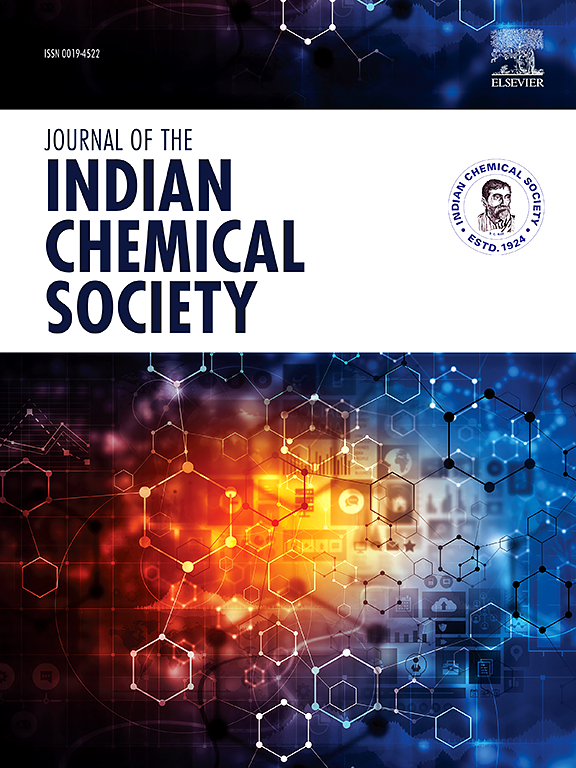含Co (II)和Cu (II)金属配合物(E)- n-(2-(4-硝基苄基)氨基)乙基)萘-1-胺的合成、计算、拓扑、抗菌和NCI分析
IF 3.2
4区 化学
Q2 CHEMISTRY, MULTIDISCIPLINARY
引用次数: 0
摘要
这项工作包括由硝基取代的芳香醛和N1-(萘-1-基)乙烷-1,2-二胺合成一种新的希夫碱配体(NED4NB)。配体随后与元素Cu(II)和Co(II)的金属离子络合。对自由配体及其金属配合物的结构、电学和光谱性质进行了详细的研究。这是通过使用实验实验和理论计算来完成的。利用傅里叶变换红外光谱、核磁共振、荧光光谱、循环伏安法(CV)、电子自旋共振(ESR)和热重分析(TGA)等技术,对金属配体配合物进行了有效的络合,并证明了其稳定性。这是通过实验表征方法完成的。为了了解电子结构、电荷分布和非共价相互作用,利用密度泛函理论(DFT)、自然键轨道(NBO)、分子静电势(MEP)、平均局域电离能(ALIE)和降低密度梯度(RDG)模拟进行了大量研究。根据对多种革兰氏阳性和革兰氏阴性菌株进行的琼脂孔扩散试验结果,Co(II)配合物比单独的自由配体和Cu(II)配合物表现出更高的抗菌活性。根据研究结果,希夫碱的生物电位通过金属配位的电调节显着增加。这表明希夫碱在光电子学和抗菌治疗领域具有很好的应用前景。本文章由计算机程序翻译,如有差异,请以英文原文为准。

Synthesis, computational, topology, antimicrobial and NCI analysis of (E)-N-(2-((4-nitrobenzylidene) amino)ethyl) naphthalen-1-amine with Co (II) and Cu (II) metal complexes
This work includes the synthesis of a novel Schiff base ligand (NED4NB) from nitro-group substituted aromatic aldehydes and N1-(naphthalen-1-yl)ethane-1,2-diamine. The ligand was subsequently complexed with metal ions of the elements Cu(II) and Co(II). All of the structural, electrical, and spectroscopic properties of the free ligand and its metal complexes were investigated in great detail. This was accomplished through the use of both experimental experiments and theoretical computations. Utilising techniques such as Fourier transform infrared spectroscopy, nuclear magnetic resonance, fluorescence spectroscopy, cyclic voltammetry (CV), electron spin resonance (ESR), and thermogravimetric analysis (TGA), the metal-ligand complexes were effectively complexed and proved to be stable. This was accomplished through the experimental characterization method. In order to gain an understanding of the electronic structure, charge distribution, and non-covalent interactions, numerous investigations were carried out utilising density functional theory (DFT), natural bond orbital (NBO), molecular electrostatic potential (MEP), average localised ionisation energy (ALIE), and reduced density gradient (RDG) simulations. According to the results of agar well diffusion tests conducted against a wide range of Gram-positive and Gram-negative bacterial strains, the Co(II) complex demonstrated a higher level of antibacterial activity compared to both the free ligand and the Cu(II) complex individually. According to the findings of the study, the biological potential of Schiff bases is significantly increased by electrical regulation through metal coordination. This indicates that Schiff bases are appealing candidates for applications in the fields of optoelectronics and antibacterial therapy.
求助全文
通过发布文献求助,成功后即可免费获取论文全文。
去求助
来源期刊
CiteScore
3.50
自引率
7.70%
发文量
492
审稿时长
3-8 weeks
期刊介绍:
The Journal of the Indian Chemical Society publishes original, fundamental, theorical, experimental research work of highest quality in all areas of chemistry, biochemistry, medicinal chemistry, electrochemistry, agrochemistry, chemical engineering and technology, food chemistry, environmental chemistry, etc.

 求助内容:
求助内容: 应助结果提醒方式:
应助结果提醒方式:


